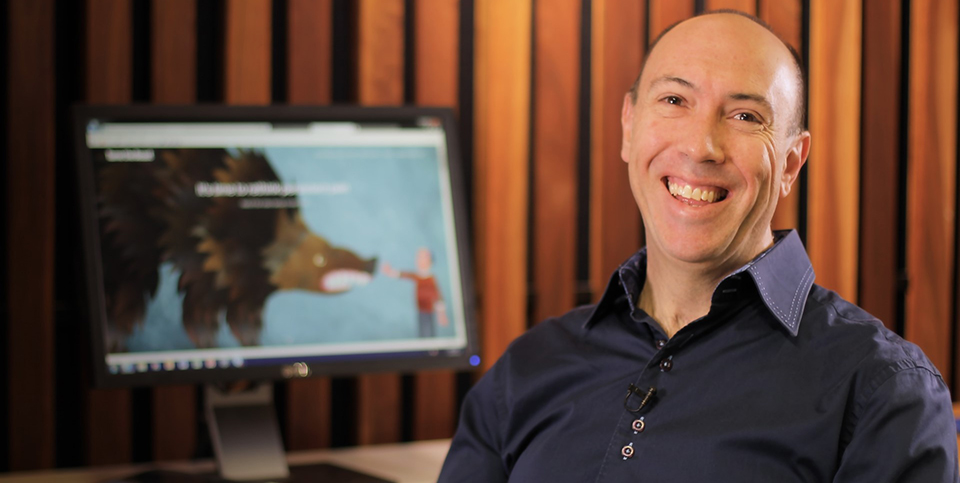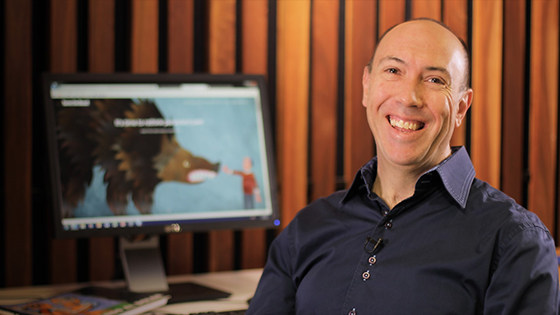
Professor Lorimer Moseley, Professor of Clinical Neurosciences and Chair in Physiotherapy at the University of South Australia, an internationally recognised pain scientist, educator and author.
We all know what pain feels like. Pain is the feeling we get when our brain is trying to make us protect part of our body. This is what makes pain so precious. But sometimes we feel pain even when our body has repaired or is no longer in danger. Our brain is overestimating our need for protection.
Internationally renowned pain scientist, Professor Lorimer Moseley, is causing a global re-think about how we experience pain and its relationship between our bodies and minds.
“Pain is an incredible mechanism that has evolved to protect us from danger,” says Professor Moseley, Head of the Body in Mind research group at University of South Australia.
“Unfortunately our brains can start overestimating the need for protection and we can start feeling pain even when there is no danger—what we call persistent or chronic pain which is fast becoming one of our largest health burdens,” he says.
“Using our research-based knowledge of the pain system, we have developed a new way of thinking about pain which is proving to help people to control and even overcome it.”
Two young Australian professionals, Abbie and James*, are just two of the chronic pain sufferers who have reduced their pain using these evidence based techniques.
Abbie says, “Getting curious about it,” helped her beat years of persistent neck pain. This is mirrored by James* who says re-educating himself was the key to reducing the pain from a knee injury, which he says was a confronting but helped him start moving again.
In the year following a minor injury to his knee, James, a successful Architect, developed immobilising pain and was diagnosed with Complex Regional Pain Syndrome.
“I stopped moving, I started protecting my knees more and more and I developed anxiety. When I was finally referred to a sports physician with an understanding of modern pain science I started to get what was happening.
The sports physician discussed modern pain research with James and suggested he read Professor Moseley’s book Explain Pain, which he says he struggled with at first as he was deeply sure that the pain was tied to his now old injury.
“When you first start trying to rethink pain you have to overcome a lifetime of ingrained beliefs that pain equals injury, and injury means ‘stop and recover’. Movement was the magic tap for me. Once I started I realised that the pain wasn’t nearly as bad as I anticipated. It gave me the confidence to keep going and within two months I drastically reduced the pain.
“I would say I’ve reduced the pain by at least 80%, which I am comfortable with considering what it was. I think the re-education was the first critical step—everything else after that was a consequence of it.”
Abbie, a physiotherapist in Western Australia, is also no stranger to persistent pain. After knocking herself unconscious in a high school synchronised swimming lesson, she developed a growing ever-present pain in her neck.
“The pain just started to become more and more constant and I had so many competing symptoms that I was seeing a number of different health professionals over a period of time,” she says.
“One day at university a lecturer presented Professor Moseley’s work. I was sitting there in the lecture theatre and I started crying because everything he was saying was what I was experiencing. It really captured my curiosity…so I bought Lorimer’s book.
“I used the techniques and came up with some of my own…and then it (the pain) just kind of went away over time, which is amazing. It’s been five years now and I don’t have persistent pain anymore,” she says.
With fast growing evidence supporting the drug-free approach to pain treatment, Professor Moseley is turning his attention to some considerable gaps in pain care, in particular the growing cancer survivor community.
“We know a lot now about how pain, the body and mind work and we know that chronic pain really needs a biopsychosocial treatment that combines psychological and social support with medical approaches,” says Professor Moseley.
“Cancer is painful and so is cancer therapy. Unfortunately, surviving cancer is often painful too,” he says. “It is staggering that up to 40% of survivors live with moderate to severe persisting pain, and it is often considered an unfortunate side-effect of beating cancer.
“I’m teaming up with cancer expert Professor Ian Olver from the UniSA Cancer Research Institute, and cancer pain scientist Dr Lauren Heathcote from Stanford University, to combine our knowledge and create a new intervention to help cancer survivors beat pain.
How you can help
“The faster we can get started, the sooner we can help one in three cancer survivors live a much happier, meaningful, and importantly, pain-free life.”
To learn more about this project and how you can help visit www.chuffed.org/project/reducing-pain-for-cancer-survivors.
*name changed to protect identity

With your support, we are taking what we know about pain, the body and mind and developing a new intervention aimed at reducing pain for cancer survivors and increasing their quality of life.
Big things can happen when we all work together. Crowdfunding@UniSA gives you the opportunity to engage directly with innovative research projects and follow their progress as our researchers work to tackle important issues. For the campaigns that reach their targets, the University of South Australia has committed to boosting all funds raised by an extra 20% - so your dollar will have even greater impact.
